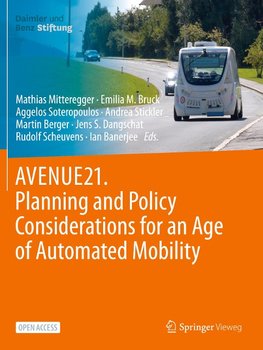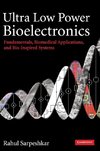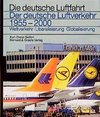
-
 Anglický jazyk
Anglický jazyk
AVENUE21. Planning and Policy Considerations for an Age of Automated Mobility
Autor: Mathias Mitteregger
The subject of this open-access publication is the impact of connected and automated vehicles on the European city and the conditions under which this technology can make a positive contribution to urban development. The authors put forward two theses that... Viac o knihe
Na objednávku
39.59 €
bežná cena: 43.99 €
O knihe
The subject of this open-access publication is the impact of connected and automated vehicles on the European city and the conditions under which this technology can make a positive contribution to urban development. The authors put forward two theses that have received little attention in the scientific discourse so far: Connected and automated vehicles will not become fully established in all sub-areas of the city for a long time. As a result, previously assumed effects - from traffic safety to traffic performance as well as spatial effects - will have to be reevaluated. To ensure a positive contribution of this technology to the mobility of the future, transport and settlement policy regulations must be further developed. Established territorial, institutional and organizational boundaries need to be challenged in a timely manner. Despite or because of the existing great uncertainties, we are at the beginning of a phase of yet shaping the possible future - in technology development, but also in politics, urban planning, administration and civil society. Description of the chapters: 1. Connected and automated driving: The long level 4 Mathias Mitteregger reflects on the road ahead for automated driving. What pathways of technological development induce which kind of spatial effects and planning needs? 2. Connected and automated driving: Consideration of the local, spatial context and spatial differentiation Emilia M. Bruck and Aggelos Soteropoulos reflect on the importance of the local context when classifying and estimating the effects of different forms of automated mobility. 3. Connected and automated driving in the context of a sustainable transport and mobility transformation Andrea Stickler, Jens S. Dangschat and Ian Banerjee integrate possible potentials of automated mobility in the context of a transformed, sustainable transport system. PART I: Mobility and transport 4. Self-driving turnaround or automotive continuity? Reflections on technology, innovation and social change Katharina Manderscheid reflects on how differing visions of an automated future can be understood with regard to divergent interests in technological development. 5. Automated drivability and streetscape compatibility in the urban-rural continuum using the example of Greater Vienna Aggelos Soteropoulos analyses how different street spaces align with technological requirements of automated mobility, creating a suitability framework for road spaces in the Greater Vienna region. 6. Automation, public transport and Mobility as a Service: Experience from tests with automated shuttle buses The authors show what types of automated public transport might be used in the future and what can be learned from testing automated shuttle buses in the past. 7. Delivery robots as a solution for the last mile in the city? Bert Leerkamp, Aggelos Soteropoulos and Martin Berger describe how automated delivery robots could be contextualized in terms of solving last-mile problems and discuss what implications might lie ahead for urban planning. PART II: Public space 8. Control and design of spatial mobility interfaces The authors identify the possible impli
- Vydavateľstvo: Springer Berlin Heidelberg
- Rok vydania: 2023
- Formát: Paperback
- Rozmer: 279 x 210 mm
- Jazyk: Anglický jazyk
- ISBN: 9783662670064











 Nemecký jazyk
Nemecký jazyk 